
Adiantum, the maidenhair fern, is a genus of about 250 species of ferns in the subfamily Vittarioideae of the family Pteridaceae, though some researchers place it in its own family, Adiantaceae. The genus name comes from Greek, meaning "unwetted", referring to the fronds' ability to shed water without becoming wet.
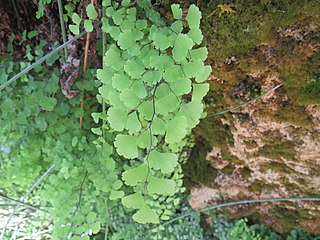
Adiantum capillus-veneris, the Southern maidenhair fern, black maidenhair fern, maidenhair fern, and venus hair fern, is a species of ferns in the genus Adiantum and the family Pteridaceae with a subcosmopolitan worldwide distribution. It is cultivated as a popular garden fern and houseplant.

Polystichum munitum, the western swordfern, is an evergreen perennial fern native to western North America, where it is one of the most abundant ferns in forested areas. It occurs along the Pacific coast from southeastern Alaska to southern California, and also inland east to southeastern British Columbia, northern Idaho and western Montana, with disjunctive populations in northern British Columbia, Canada; the Black Hills in South Dakota, United States; and Guadalupe Island off of Baja California, Mexico. Western swordfern is known to have locally naturalized in parts of Great Britain and Ireland.

Davallia is a genus of about 40 species of fern. In the Pteridophyte Phylogeny Group classification of 2016, it is the only genus in the family Davalliaceae, which is placed in the suborder Polypodiineae, order Polypodiales. Alternatively, the family may be placed in a very broadly defined family Polypodiaceae sensu lato as the subfamily Davallioideae.

Alsophila capensis, synonym Cyathea capensis, is a regionally widespread and highly variable species of tree fern. It is indigenous to Southern Africa and South America.

Adiantum aleuticum, the western maidenhair fern or Aleutian maidenhair, is a species of deciduous fern in the genus Adiantum.
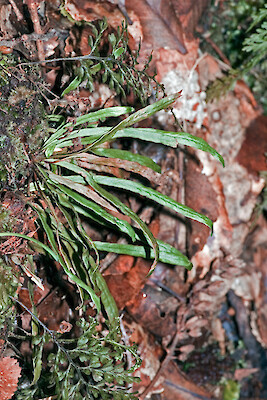
Notogrammitis billardierei, also known as the common finger-fern, or common strap fern, is a small epiphytic or lithophytic fern [1] with small, strap like fronds, found commonly in wet forest in South-Eastern Australia and New Zealand.
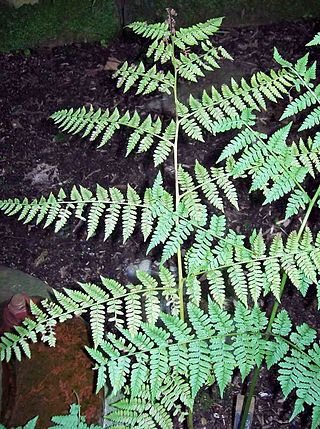
Diplazium australe, commonly known as the Austral lady fern, is a small fern occurring in eastern Australia, New Zealand and Norfolk Island. The habitat is moist shaded areas, often occurring in rainforest.

Calochlaena dubia, commonly known as soft bracken, false bracken, common ground fern or rainbow fern, is a small Australian fern in the treefern family Dicksoniaceae. It is very common within its range, and often seen growing under eucalyptus forest, often on the poorer quality soils. It is an easy plant to grow in the garden.

Gleichenia dicarpa, commonly known as pouched coral fern or tangle fern, is a small fern of the family Gleicheniaceae found in eastern Australia, New Caledonia and New Zealand. It forms tangled thickets in wet places such as swamps and riverbanks.

Angiopteris evecta, commonly known as the king fern, giant fern, elephant fern, oriental vessel fern, Madagascar tree fern, or mule's Foot fern, is a very large rainforest fern in the family Marattiaceae native to most parts of Southeast Asia and Oceania. It has a history dating back about 300 million years, and is believed to have the longest fronds of any fern in the world.

Gleichenia microphylla is a small fern growing in Australia and New Zealand.
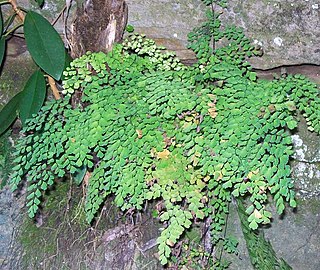
Adiantum aethiopicum, also known as the common maidenhair fern, is a small fern of widespread distribution, occurring in Africa, Australia, Norfolk Island and New Zealand.
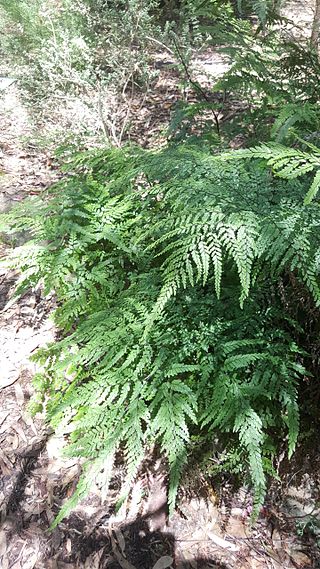
Adiantum formosum, known as the giant maidenhair or black stem maidenhair is a fern found in Australia and New Zealand. It was one of the many species authored by Scottish botanist Robert Brown, appearing in his 1810 work Prodromus Florae Novae Hollandiae et Insulae Van Diemen. Its species name is the Latin adjective formosus "handsome" or "beautiful".
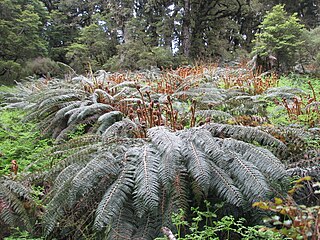
Polystichum vestitum, commonly known as the prickly shield fern or pūnui (Maori), is a hardy, evergreen or semi-evergreen ground fern.

Adiantum viridimontanum, commonly known as Green Mountain maidenhair fern, is a fern found only in outcrops of serpentine rock in New England and Eastern Canada. The leaf blade is cut into finger-like segments, themselves once-divided, which are borne on the outer side of a curved, dark, glossy rachis. These finger-like segments are not individual leaves, but parts of a single compound leaf. The "fingers" may be drooping or erect, depending on whether the individual fern grows in shade or sunlight. Spores are borne under false indusia at the edge of the subdivisions of the leaf, a characteristic unique to the genus Adiantum.

Nephrolepis cordifolia, is a fern native to the global tropics, including northeastern Australia and Asia. It has many common names including fishbone fern, tuberous sword fern, tuber ladder fern, erect sword fern, narrow sword fern and ladder fern, and herringbone fern. It is similar to the related fern Nephrolepis exaltata.
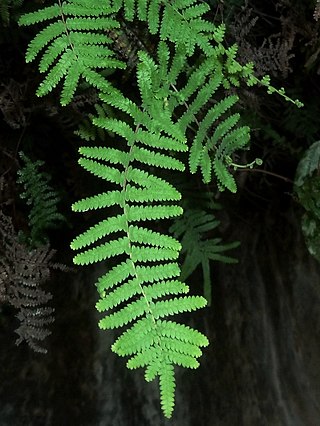
Gleichenia polypodioides (L.) Sm., commonly known as coral fern, kystervaring or ystervaring due to its glabrous, brown, wiry stipes. The species is widespread in south- and east tropical Africa, southern Africa and the western Indian Ocean region. It occurs naturally in a broad coastal belt in South Africa, Lesotho, Eswatini, Angola, Malawi, Burundi, Tanzania, Mozambique, Zimbabwe, Mauritius, Réunion, Amsterdam Island and Madagascar, and was first described by Carl Linnaeus in 1771 under the name Onoclea polypodioides. Often forming dense and impenetrable thickets, sometimes over large areas, this rhizomatous perennial is an important pioneer in disturbed areas such as pine plantations. It is often mistakenly seen as an exotic invader rather than as a useful rehabilitation plant, a source of peat and growing medium, while showing exceptional resistance to herbicides.
Rhizome brown, 1–2.5 mm. in diam., creeping, with long-spined dark-brown scales up to 0.5 mm. in diam., with fronds spaced 2–20 cm. apart. Stipe castaneous, up to 60 cm. long and up to 1.5 mm. in diam., glabrous or with a few scales similar to those on the rhizome, shallowly sulcate. Frond bifurcate to reniform-lunate in outline, with 1 level of false dichotomy in each lateral branch system arising from each side of the terminal bud; all branches bearing distant foliar segments. Aborted apical buds up to 1.2 mm. long, clothed in dark-brown lanceolate laciniate scales. Pinnules linear, up to 7 x 0.75 cm., pinnate, usually glabrous, divided into sessile rounded entire triangular lobes, 3 x 2 mm., green to glaucous below. Sori partially immersed in the lamina, consisting of 2–4 sporangia, each in a separate but adjoining pit.
Tasmania is home to 'Australia’s largest cool temperate rainforests. Most of Tasmania’s rainforests occur in the North-West and throughout the North East highlands. Cool temperate rainforests typically have a heavy rainfall, cool climate, favor high altitudes and have a limited availability of light.

Asplenium appendiculatum, ground spleenwort, is a common native fern to Australia and New Zealand. It usually grows in cool damp conditions, among rocks, on logs or as an epiphyte.


















